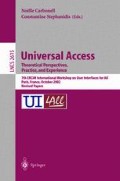Abstract
Touch-Screen Technology is the most natural of all input devices — even children can easily learn how to operate them. But this simple interaction proved also to be ideal for people who are not overly familiar with computers including elderly and/or disabled patients in a hospital. A pilot system of an interactive Patient Communications System (PACOSY) has been developed in a User Centered Design (UCD) process. Patients were enabled to retrieve and enter information interactively via various touch screen systems connected to the Hospital Intranet. This paper concentrates primarily on experimental experiences with touch technology and the technological requirements for a touch based Patient Information System (PATIS) serving as Point of Information (POI) for patients within a hospital or a future Point of Consultation (POC). People with low or no computer literacy found using touch screens easy and motivating. Together with a cheap, simple and user friendly interface design, such systems can enhance universal access within an information society for all.
“Each Pointing concept has its enthusiasts and detractors, motivated by commercial interests, by personal preference and increasingly by empirical evidence” (Ben Shneiderman, 1998, p.323 [1]).”
Access this chapter
Tax calculation will be finalised at checkout
Purchases are for personal use only
Preview
Unable to display preview. Download preview PDF.
References
Shneiderman, B. Designing the User Interface. Strategies for Effective Human-Computer Interaction. Reading (MA): Addison Wesley (1998)
Holzinger, A., User-Centered Interface Design for disabled and elderly people: First experiences with designing a patient communication system (PACOSY), In: Computers Helping People with Special Needs, 8th International Conference, ICCHP, Linz, K. Miesenberger, J. Klaus, and W. Zagler (ed.), Berlin et al.: Springer (2002) 34–41
Stephanidis, C., Savidis, A. Universal Access in the Information Society: Methods, Tools and Interaction Technologies, Universal Access in the Information Society, 1 (1) (2001) 40–55
Emiliani, L.P., Stephanidis, C. From Adaptations to User Interfaces for All. 6th ERCIM Workshop “User Interfaces for All”. Florence, Italy: (2000)
McMillan, S. Literacy and computer literacy: definitions and comparisons, Computers & Education, 27 (3–4) (1996) 161–170
King, J., Bond, T., Blandford, S. An investigation of computer anxiety by gender and grade, Computers in Human Behavior, 18 (1) (2002) 69–84
Robertson, G.L., Hix, D. Making Computer Accessible to Mentally Retarded Adults, Communications of the ACM, 45 2002) 171–183
Lewis, D. Computer-based approaches to patient education: a review of the literature, Journal of the American Medical Informatics Association: JAMIA, 6 (4) (1999) 272–282
Rippey, R.M., Bill, D., Abeles, M., Day, J., Downing, D.S., Pfeiffer, C.A., Thal, S.E., Wetstone, S.L. Computer-based patient education for older persons with osteoarthritis, Arthritis and Rheumatism, 30 (8) (1987) 932–935
Downing, D.S., Rippey, R., Peterson, M., Weinstein, A., Sheehan, T.J. Rheumatology education in an undergraduate program of physical therapy. A new outlook, Physical Therapy, 67 (9) (1987) 1393–1398
Bill-Harvey, D., Rippey, R., Abeles, M., Donald, M.J., Downing, D., Ingenito, F., Pfeiffer, C.A. Outcome of an osteoarthritis education program for low-literacy patients taught by indigenous instructors, Patient Education and Counseling, 13 (2) (1989) 133–142
Jones, J.M., Nyhof-Young, J., Friedman, A., Catton, P. More than just a pamphlet: development of an innovative computer-based education program for cancer patients, Patient Education and Counseling, 44 (3) (2001) 271–281
Ellis, L.B.M. Computer-based patient education, Computers in Human Services, 2 (3–4) (1987) 117–130
Bental, D.S., Cawsey, A., Jones, R. Patient Information Systems that tailor to the individual., Patient Education and Counseling, 36 1999) 171–180.
Hanna, A.W., Pynsent, P.B., Learmonth, D.J., Tubbs, O.N. A comparison of a new computer-based interview for knee disorders with conventional history taking, The Knee, 6 (4) (1999) 245–256
van’t Riet, A., Berg, M., Hiddema, F., Sol, K. Meeting patients’ needs with patient information systems: potential benefits of qualitative research methods, International Journal of Medical Informatics, 64 (1) (2001) 1–14
Brennan, P.F., Kuang, Y.S., Volrathongchai, K., Patient-centered information systems: Patient Centered Systems, In: Yearbook of Medical Informatics 2000, J.H.v. Bemmel and A.T. McCray (ed.), Stuttgart: Schattauer (2000) 79–86
Peterson, L., Johannsson, V. Computerized Testing in a Hospital Setting: Psychometric and Psychological Effects, Computers in Human Behavior, 12 (3) (1996) 339–350
Nielsen, J. Usability Engineering. New York: Academic Press (1993)
Greenstein, J.S., Arnaut, L.Y., Input Devices, In: Handbook of Human-Computer Interaction, M. Helander (ed.), Amsterdam: North Holland (1988) 495–519
Srinivasan, M.A., Basdogan, C. Haptics in virtual environments: taxonomy, research status, and challenges, Computers & Graphics, 21 (4) (1997) 393–404
Holzinger, A. Multimedia Basics, Volume 1: Technology. Technological Fundamentals of multimedial Information Systems. New Delhi: Laxmi Publications (2002)
Holzinger, A. Basiswissen Multimedia. Band 1: Technologische Grundlagen multimedialer Informationssyteme. 2. Auflage. Würzburg: Vogel (2002)
Fitts, P.M. The information capacity of the human motor system in controlling the amplitude of movement, Journal of Experimental Psychology, 47 1954) 381–391
MacKenzie, I.S. Fitts’ law as a research and design tool in human-computer interaction, Human-Computer Interactions, 7 (1) (1992) 91–139
Schultz, K.L., Batten, D.M., Sluchak, T.J. Optimal viewing angle for touch-screen displays: Is there such a thing?, International Journal of Industrial Ergonomics, 22 (4–5) (1998) 343–350
Zajicek, M. Interface Support for Elderly People with Impaired Sight or Memory. 6th ERCIM Workshop “User Interfaces for All”. Florence, Italy: (2000)
McTear, M.F. Spoken Dialogue Technology: Enabling the Conversational User Interface, ACM Computing Surveys, 34 (1) (2002) 90–169
Stephanidis, C. From User Interfaces for all to an Information Society for All: Recent achievements and future challenges. 6th ERCIM Workshop “User Interfaces for All”. Florence, Italy: (2000)
Author information
Authors and Affiliations
Editor information
Editors and Affiliations
Rights and permissions
Copyright information
© 2003 Springer-Verlag Berlin Heidelberg
About this paper
Cite this paper
Holzinger, A. (2003). Finger Instead of Mouse: Touch Screens as a Means of Enhancing Universal Access. In: Carbonell, N., Stephanidis, C. (eds) Universal Access Theoretical Perspectives, Practice, and Experience. UI4ALL 2002. Lecture Notes in Computer Science, vol 2615. Springer, Berlin, Heidelberg. https://doi.org/10.1007/3-540-36572-9_30
Download citation
DOI: https://doi.org/10.1007/3-540-36572-9_30
Published:
Publisher Name: Springer, Berlin, Heidelberg
Print ISBN: 978-3-540-00855-2
Online ISBN: 978-3-540-36572-3
eBook Packages: Springer Book Archive

